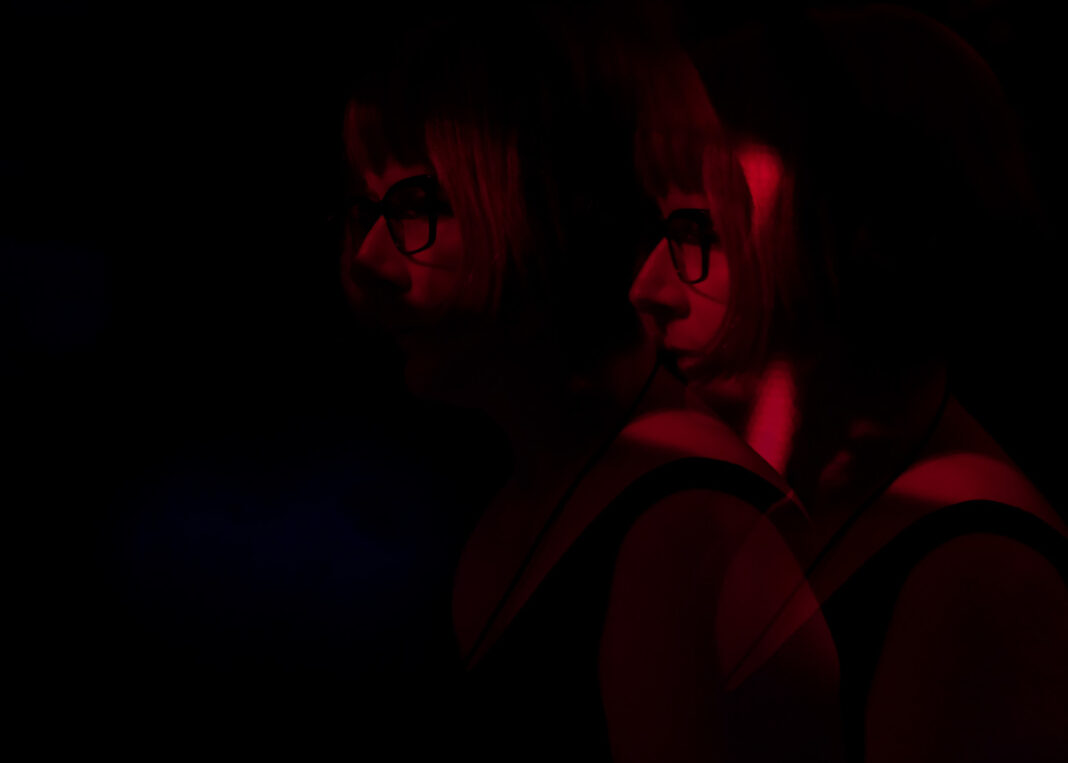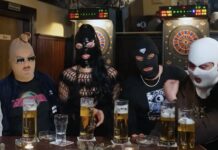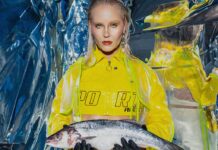
Photo: Diane Michelle (Erika)
When Erika Sherman says that she quickly gets “sick of hearing the same things over and over again,” that explains a lot. Whether it was running her own online radio, joining the ever-fluid Ectomorph project along BMG and others as well as the affiliated Interdimensional Transmissions label, the Detroit- and Berlin-based producer and DJ has continuously pushed the envelope in search for something greater than that which is already out there. Having just released an album’s worth of tracks that evolved over time through her live sets with Anevite Void, her contribution to our Groove podcast captures her venturing into uncharted territory. Recorded live at one of Interdimensional Transmissions’ No Way Back parties, the set exclusively features tunes that she had never played before.
You currently split your time between Berlin and Detroit. How did that come about and how is it, working across different continents and time zones?
It’s a natural blend for me. I love the atmosphere and people of both cities so much, they complement each other quite well. There’s so many intertwined ideas. I personally enjoy the mental adventure of being in multiple places and multiple time zones. It feels natural to me.
Anevite Void, your newly released solo album, is originally based on tracks written for your live sets. How did you turn it into an album? Would you say that there is a narrative or concept that unites these tracks?
Every time I have a live set coming, I write at least a couple of new tracks. I get sick of hearing the same things over and over again, so it’s important for me to keep changing and evolving the set, to keep it fresh to my ears. Therefore, when I begin jamming and writing, I stick within a certain soundscape, based on the gear I’m currently using, limited to what’s possible using the current live setup. Then I take the tracks out to gigs, play them a few times, learn how they feel and how they work, and bring them back to the studio for recording. Before recording anything, I listen to each track in the studio, exactly the way it works in the live set, and start to imagine how it could be evolved to become just a little bit more unique or special. I might then make some changes to the sound design, for example: swap out a drum sound from my RYTM to something from the 808, develop a new reverb setting on the Space, or run a synth through the MuRF. So while the tracks all began in the same place, from here they can diverge some, as I use different equipment to refine the sound design for each piece. I recorded the tracks on this album all in the same time period, so they are aurally united by a specific style of production and recording, defined by how my studio was set up at the time. Conceptually, these tracks are united and sequenced by what I was thinking about when I did the last bits of production work, which is the Anevite Void. Each track tells a different part of the story of the life cycles on this imagined world.
The word “Anevite” in the title seems to be a neologism. What does it mean?
It’s actually a proper noun. Anevite is the name of a planet; Anevite Void is the experience of being on the planet when all three of its suns have set and the surface is plunged into darkness—a reprieve from radiation, a time of celebration. Detroit-based motion artist Andrew Charles Edman created a video for the track “Star Line Down” which is about this specific moment.
You mentioned that the album reflected your setup at the time of writing and recording the album. What kind of hardware did you use for this album—were there pieces of gear that were especially important?
It began on the equipment I use in my live sets: a sequencer (Octopus), drum machine (Analog RYTM), four synthesizers (Moog Minitaur, Waldorf Pulse2, Waldorf Blofeld, and a monosynth), and three pedals (Moog Delay, Empress Phaser, and Strymon BlueSky). The most important piece of gear is, by far, the Octopus. It’s my music brain, I write everything here, all of the drum and synth parts. I don’t use any of the sequencers on any other piece of gear. Everything else can be swapped out, the rest of the gear is for sound design, but the Octopus is what makes the ideas flow. When I take the tracks back to thes studio to record, it’s super easy to direct a sequence to a different machine, so I can do the exploratory sound design that I describe above, to switch out instruments and make adjustments to a soundscape before recording. Everyone who took part in making this record happen is listed on its back cover.
After the Ectomorph reunion in 2016, you released the late debut Stalker two years later and followed that up with a live recording released in the first months of the pandemic. Are you currently interested in releasing more records?
We just finished a recording session that will become the next release once we finish the engineering and production work.
Together with Ectomorph’s BMG and Amber Gillen, you run the Interdimensional Transmissions label, where Anevite Void was released, and you also put on events such as the festival Return To The Source in late May. How do these events and your work with the label tie in with each other?
The events and the label both support our larger community, and are wholly intertwined from a creative perspective. Our No Way Back residents are responsible for many of the label’s recent releases—Patrick Russell as half of Pervocet, BMG and Derek Plaslaiko in collaboration, Eris Drew’s solo work, myself and BMG in collaboration as Ectomorph, and my solo releases. Jasen Loveland and Adam Arthur are two artists who came to us through No Way Back, who were so inspired by attending that they were driven to make music specifically for the parties.
You are also affiliated with Sebastian Mullaert’s Circle of Live project and have hosted a mentorship programme focusing on live music in 2021. What is the most crucial piece of advice you would give to an artist who is considering to play live but doesn’t know where to start?
Rather than try to build a whole setup at once, pick one piece of gear to start with. Which piece depends on what you’re trying to accomplish stylistically, but a drum machine is a good place to start, or maybe a synthesizer. Learn this machine deeply, really push it to its limits, become fluid with it, and figure out what it can and can’t do for you. Then, when you choose to add something else—say, a synthesizer, or a delay pedal—you already have a solid foundation: you know exactly what to expect from what you already have. Learn the new machine, and how these two work and feel together; they will become your expanded foundation. Continue to build upon this until you have what you need to be fluid, and fully articulate your own sound.
Shortly after joining Ectomorph, you started an online radio station, erika.net, that existed for many years. In 1999, that was arguably a novel concept. How did it come about that you started it and why was it discontinued?
From 1993-1999, I was very involved with the radio station WCBN-FM in Ann Arbor, where I attended university. 1999 was when I was (mostly) done with classes, taking a step back from student life, and returning to full-time tech work. I had recently set up online streaming for WCBN, so had a good idea about how streaming audio worked, from a technical perspective. I had a huge, curated collection of MP3s at my house; I was ripping CDs as much as I could, constantly expanding the playlist that was on shuffle at home, trying to surprise myself by hearing songs I hadn’t heard before. Being away at work so much, I was missing my own music collection, and didn’t always want to hear the radio—people are always talking! So distracting! (laughs) So I decided to stream from my house. At first, it was just so I could listen in the office, but I found an inexpensive relay service and decided to pay out of pocket to broadcast to the rest of the world. As the legal world caught up to tech, it became prohibitively expensive for me to continue running the stream, because I do not believe in advertising, and didn’t have the time to build the kind of community you need to have something like this truly be successful. I definitely miss doing radio, and it’s always in the back of my mind to figure out how to bring it back…
What was the idea behind your mix for our Groove podcast?
I decided to submit my live mix from a week ago at No Way Back, recorded between 7:30 and 9 on Monday morning, after BMG and before Eris Drew. At No Way Back, I am pulled in a million different directions, between running the weekend of events, seeing so many friends, and of course, performing. My attention is all over the place, and I’m running on a pretty intense sleep deficit, yet I am faced with playing the most important DJ set of the year. I learned years ago that I can’t actually prepare as a DJ for this party; the times I’ve attempted to plan ahead, I wound up playing completely different music, because I simply can not know ahead of time where the crowd and vibe will take me in the moment. It’s best to be purely improvisational, to feel the energy and the flow, rather than approach with a strong idea about how or what to play. Besides, I feel that I’m at my best as a DJ when I don’t actually know what’s going on, being forced to listen and respond. So to prepare for my No Way Back set this year, I spent four minutes creating a playlist of tracks with 0-1 “DJ play count”—meaning, I’d probably never played them before, and definitely don’t know what they sound like. I chose a track with an intro and moved it to the first position in the list, because I knew I’d have about 45 seconds between stepping into the booth and pressing play. I made it to the booth with no time to spare, loaded my thumb drive, pressed play on that track, and took it from there. What you hear in this mix is me in my most basic flow state lizard brain DJ zone, feeling it out for the best crowd in the world.
Last but not least: what are your plans for the future?
Keep making music!
Stream: Erika – Groove Podcast 381
01. False Persona – Forward Motion [brokntoys]
02. Kerrie – Theta State [Blueprint]
03. Linear System – Static Position [Illegal Alien Records]
04. Acid Pimp – Acid Clock [AcidWorx]
05. Fossil Archive – The Red Demon [Kneaded Pains]
06. Mike Parker – The Burning Roundtable [Token]
07. Zeta Reticula – Isolate [Science Cult]
08. Nørbak – Pária [NRBK]
09. Orbe – Cephalon [Orbe Records]
10. DJ Nobu – Comet [Non Series]
11. Erika – Wandering Mountain (Mike Parker Remix) [Interdimensional Transmissions]
12. Peter Van Hoesen – Purity Death Spiral [Time to Express]
13. Marcelo Antonio – Ancestrales [UTCH Records]
14. Quelza – Aragaran (DJ Boss remix) [RND Records]
15. E-Runner – Lost Highway [AcidWorx]
16. DJ Shufflemaster – Guiding Light [Tresor]
17. Urstadt – Ritornel One (Developer Remix) [Wunderblock Records]
18. MPak, Quantum Computer Code – Elephants [Xelima Records]
19. Reeko – Reach a Climax [Ownlife]
20. SRAMAANA & Rommek – Binary Error [Skryptöm records]
21. Galaxian – Overshoot [Micron Audio]
22. Kerrie – Transient Belief [Blueprint]
23. Urstadt – Ritornel One [Wunderblock Records]
24. Kr!z – The Ceremony [Token]
25. MTHEOREM – Night Voodo [Urbsounds]
26. Postdynamic – Tungsteno (Linear System remix) [Post Dynamic Records]
27. Franco Rossi & Dhalgren – Angila [Xelima Records]
28. Irazu – Searching the reason [Semantica]
29. SHXCXCHCXSH – Primos [Enux Records]
30. CaRon – Reflection [brokntoys]




